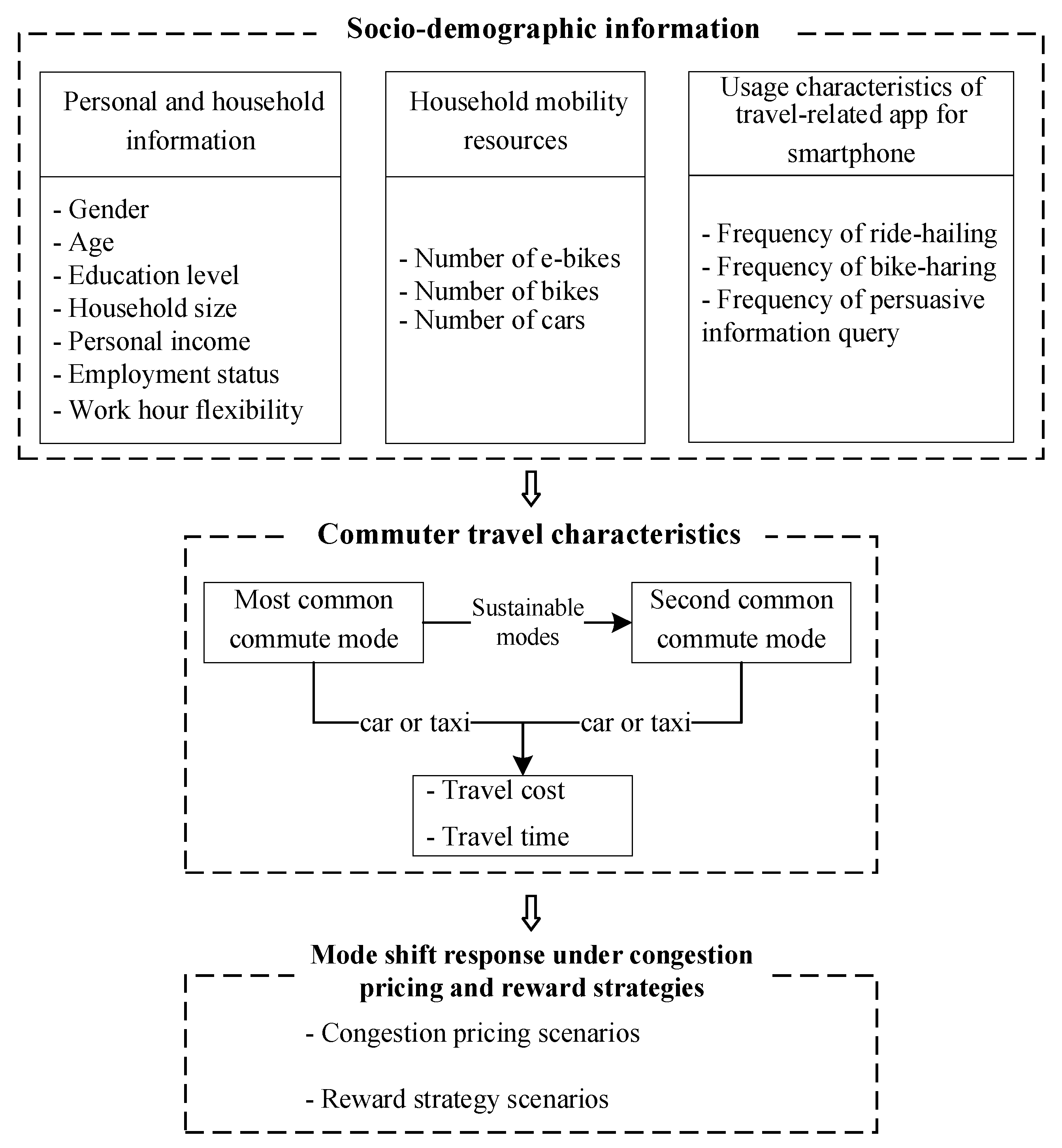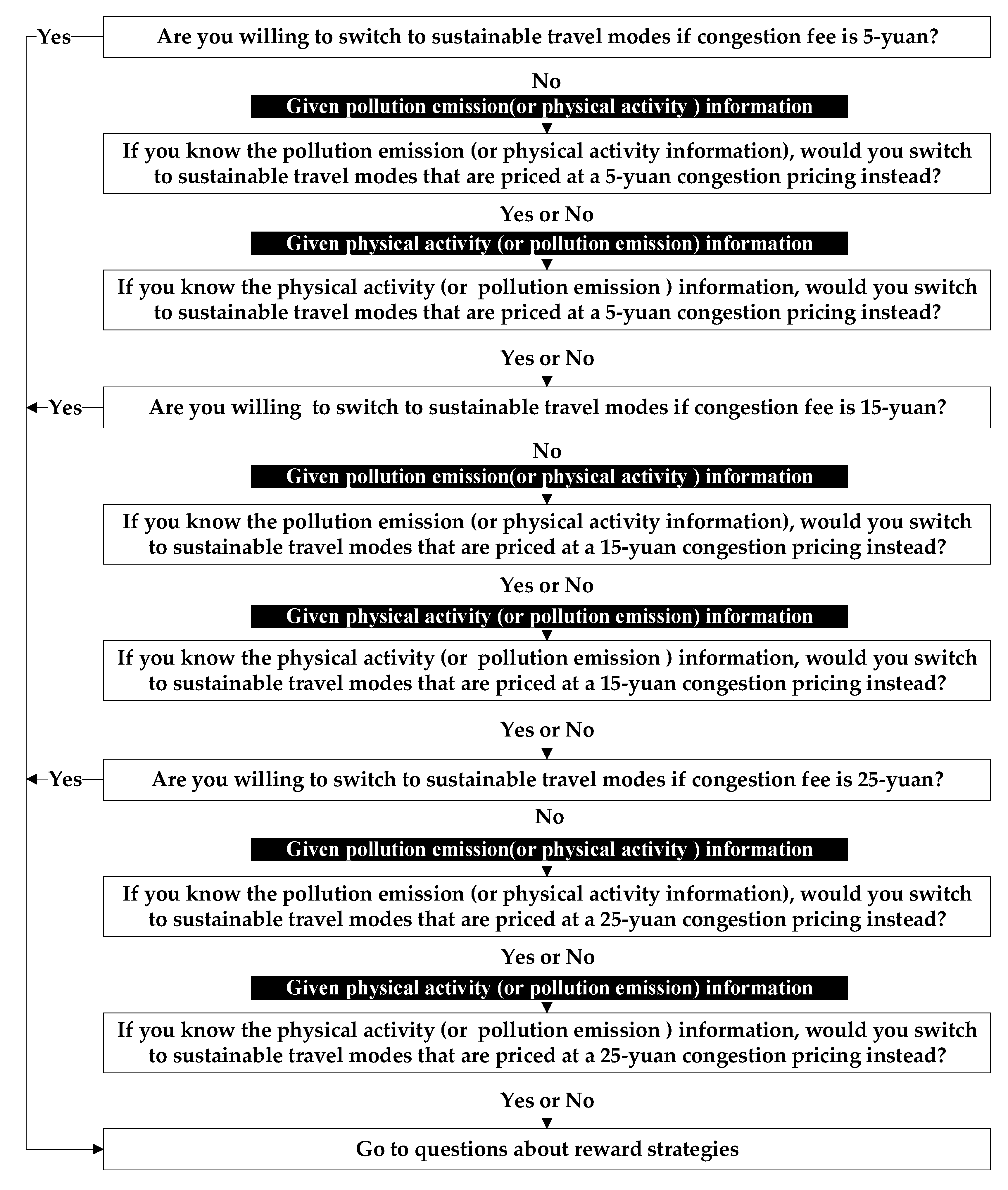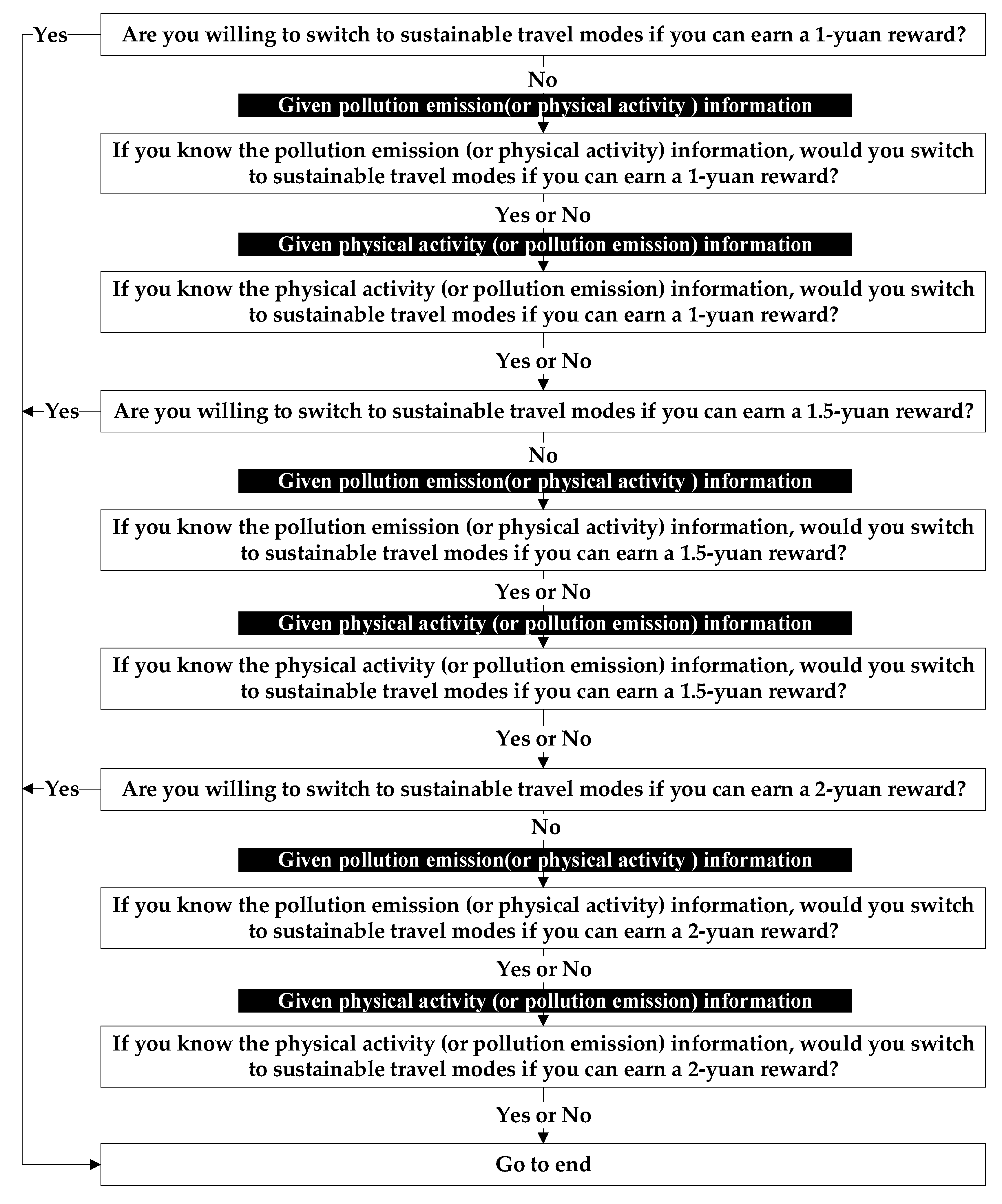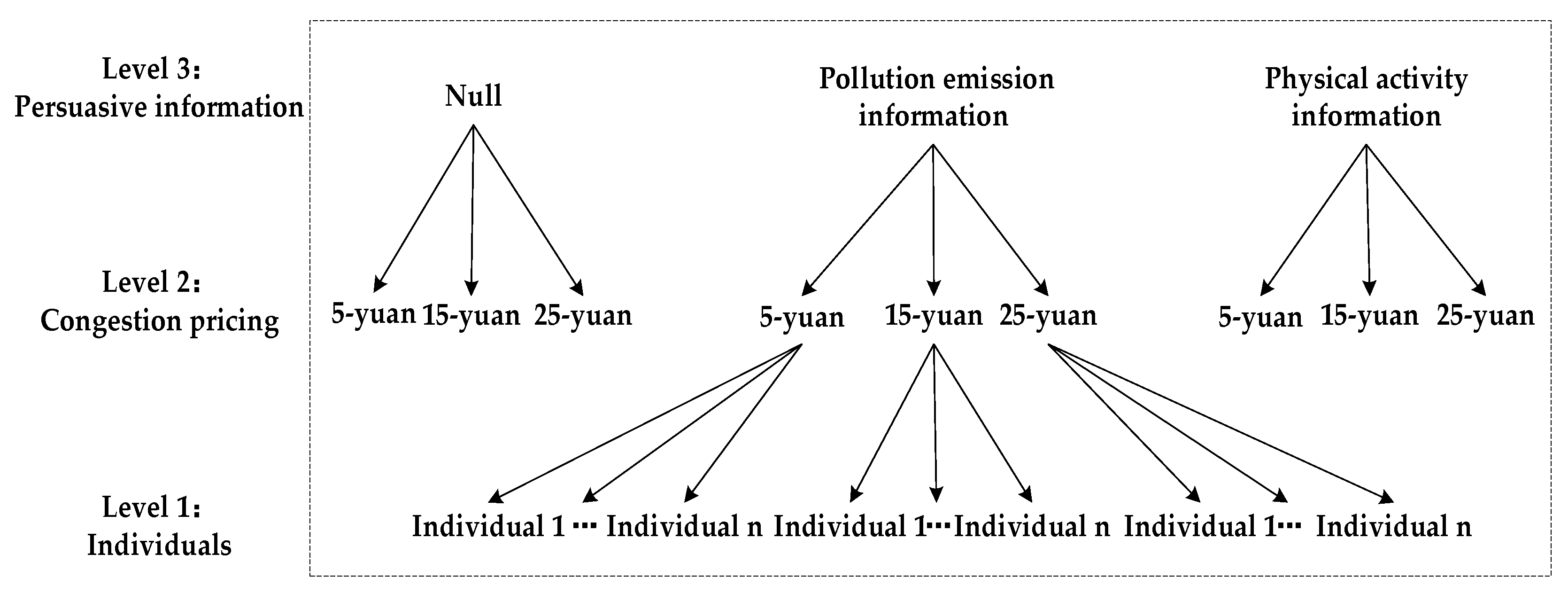Joint Impacts of Pricing Strategies and Persuasive Information on Habitual Automobile Commuters’ Travel Mode Shift Responses
Abstract
1. Introduction
- Can persuasive information be used as complementary measures to enhance the impact of pricing strategies on habitual automobile commuters’ travel mode shift responses?
- How can one evaluate the effect of persuasive information on pricing strategies with respect to promoting automobile mode choice behavior changes?
- What are the similarities and dissimilarities in the factors influencing travel mode shifts response of more and less habitual automobile commuters when subjected to the joint impact of pricing strategies and persuasion information?
2. Study Design and Data
3. Model Specification
4. Results and Discussion
4.1. The Effect of Persuasive Information on Pricing Strategies Promoting Automobile Mode Choice Behavior Change
4.2. Joint Impacts of Pricing Strategies and Persuasive Information on Habitual Automobile Commuters’ Travel Mode Shift Responses
5. Conclusions
Author Contributions
Funding
Informed Consent Statement
Data Availability Statement
Conflicts of Interest
References
- Beijing Transport Institute. 2021 Beijing Transport Development Annual Report. Available online: https://www.bjtrc.org.cn/Show/download/id/68/at/0.html (accessed on 3 September 2021).
- Khademi, E.; Timmermans, H. Incorporating Traveler Response to Pricing Policies in Comprehensive Activity-Based Models of Transport Demand: Literature Review and Conceptualization. Procedia Soc. Behav. Sci. 2011, 20, 594–603. [Google Scholar] [CrossRef][Green Version]
- De Palma, A.; Lindsey, R. Traffic congestion pricing methodologies and technologies. Transp. Res. Part C Emerg. Technol. 2011, 19, 1377–1399. [Google Scholar] [CrossRef]
- Cipriani, E.; Mannini, L.; Montemarani, B.; Nigro, M.; Petrelli, M. Congestion pricing policies: Design and assessment for the city of Rome, Italy. Transp. Policy 2019, 80, 127–135. [Google Scholar] [CrossRef]
- Cohen-Blankshtain, G.; Bar-Gera, H.; Shiftan, Y. Congestion pricing and positive incentives: Conceptual analysis and empirical findings from Israel. Transportation 2022, 1–27. [Google Scholar] [CrossRef]
- Chen, D.; Ignatius, J.; Sun, D.; Goh, M.; Zhan, S. Impact of congestion pricing schemes on emissions and temporal shift of freight transport. Transp. Res. E Logist. Transp. Rev. 2018, 118, 77–105. [Google Scholar] [CrossRef]
- Noordegraaf, D.V.; Annema, J.A.; van Wee, B. Policy implementation lessons from six road pricing cases. Transp. Res. Part A Policy Pract. 2014, 59, 172–191. [Google Scholar] [CrossRef]
- Link, H. Is car drivers’ response to congestion charging schemes based on the correct perception of price signals? Transp. Res. Part A Policy Pract. 2015, 71, 96–109. [Google Scholar] [CrossRef]
- Ben-Elia, E.; Ettema, D. Changing commuters’ behavior using rewards: A study of rush-hour avoidance. Transp. Res. Part F Traffic Psychol. Behav. 2011, 14, 354–368. [Google Scholar] [CrossRef]
- Khademi, E.; Timmermans, H. The long-term effectiveness of a reward scheme in changing daily travel choices. Procedia Soc. Behav. Sci. 2014, 111, 380–389. [Google Scholar] [CrossRef]
- Kumar, V.; Bhat, C.R.; Pendyala, R.M.; You, D.; Ben-Elia, E.; Ettema, D. Impacts of incentive-based intervention on peak period traffic: Experience from the Netherlands. Trans. Res. Rec. 2016, 2543, 166–175. [Google Scholar] [CrossRef]
- Tillema, T.; Ben-Elia, E.; Ettema, D.; van Delden, J. Charging versus rewarding: A comparison of road-pricing and rewarding peak avoidance in the Netherlands. Transp. Policy 2013, 26, 4–14. [Google Scholar] [CrossRef]
- Kandolath, U.S. Regulating travel demand for sustainable transport: Road pricing versus incentive schemes. In Green Buildings and Sustainable Engineering; Drück, H., Mathur, J., Eds.; Springer: Singapore, 2019; pp. 259–264. [Google Scholar]
- Guo, Y.; Li, Y.; Anastasopoulos, P.C.; Peeta, S.; Lu, J. China’s millennial car travelers’ mode shift responses under congestion pricing and reward policies: A case study in Beijing. Travel. Behav. Soc. 2021, 23, 86–99. [Google Scholar] [CrossRef]
- Andersson, A.; Hiselius, L.W.; Adell, E. Promoting sustainable travel behaviour through the use of smartphone applications: A review and development of a conceptual model. Travel. Behav. Soc. 2018, 11, 52–61. [Google Scholar] [CrossRef]
- Semanjski, I.; Aguirre, L.; De Mol, J.; Gautama, S. Policy 2.0 Platform for Mobile Sensing and Incentivized Targeted Shifts in Mobility Behavior. Sensors 2016, 16, 1035. [Google Scholar] [CrossRef] [PubMed]
- Sunio, V.; Schmöcker, J.D. Can we promote sustainable travel behavior through mobile apps? Evaluation and review of evidence. Int. J. Sustain. Transp. 2017, 11, 553–566. [Google Scholar] [CrossRef]
- Jariyasunant, J.; Abou-Zeid, M.; Carrel, A.; Ekambaram, V.; Gaker, D.; Sengupta, R.; Walker, J.L. Quantified traveler: Travel feedback meets the cloud to change behavior. J. Intell. Transp. Syst. 2015, 19, 109–124. [Google Scholar] [CrossRef]
- Anagnostopoulou, E.; Urbančič, J.; Bothos, E.; Magoutas, B.; Bradesko, L.; Schrammel, J.; Mentzas, G. From mobility patterns to behavioural change: Leveraging travel behaviour and personality profiles to nudge for sustainable transportation. J. Intell. Inf. Syst. 2020, 54, 157–178. [Google Scholar] [CrossRef]
- Li, T.; Chen, P.; Tian, Y. Personalized incentive-based peak avoidance and drivers’ travel time-savings. Transp. Policy 2021, 100, 68–80. [Google Scholar] [CrossRef]
- Cellina, F.; Bucher, D.; Mangili, F.; Veiga Simão, J.; Rudel, R.; Raubal, M. A large scale, app-based behaviour change experiment persuading sustainable mobility patterns: Methods, results and lessons learnt. Sustainability 2019, 11, 2674. [Google Scholar] [CrossRef]
- Li, Y.; Guo, Y.; Lu, J.; Peeta, S. Impacts of congestion pricing and reward strategies on automobile travelers’ morning commute mode shift decisions. Transp. Res. Part A Policy Pract. 2019, 125, 72–88. [Google Scholar] [CrossRef]
- Linn, J.; Wang, Z.; Xie, L. Who will be affected by a congestion pricing scheme in Beijing? Transp. Policy 2016, 47, 34–40. [Google Scholar] [CrossRef]
- Sun, X.; Feng, S.; Lu, J. Psychological factors influencing the public acceptability of congestion pricing in China. Transp. Res. Part F Traffic Psychol. Behav. 2016, 41, 104–112. [Google Scholar] [CrossRef]
- China Daily. Top 10 Chinese Cities with Highest Average Monthly Salary. Available online: http://africa.chinadaily.com.cn/business/2017-06/23/content_29862396.htm (accessed on 23 June 2017).
- Jiang, S.; Cai, C. Unraveling the dynamic impacts of COVID-19 on metro ridership: An empirical analysis of Beijing and Shanghai, China. Transp. Policy 2022, 127, 158–170. [Google Scholar] [CrossRef] [PubMed]
- Paul, T.; Chakraborty, R.; Anwari, N. Impact of COVID-19 on daily travel behaviour: A literature review. Transp. Saf. Environ. 2022, 4, tdac013. [Google Scholar] [CrossRef]
- Das, S.; Boruah, A.; Banerjee, A.; Raoniar, R.; Nama, S.; Maurya, A.K. Impact of COVID-19: A radical modal shift from public to private transport mode. Transp. Policy 2021, 109, 1–11. [Google Scholar] [CrossRef]
- Beijing Transport Institute. 2018 Beijing Transport Development Annual Report. Available online: https://www.bjtrc.org.cn/Show/download/id/18/at/0.html (accessed on 24 October 2018).
- Hedeker, D. A mixed-effects multinomial logistic regression model. Stat. Med. 2003, 22, 1433–1446. [Google Scholar] [CrossRef]
- Snijders, T.A.B.; Bosker, R.J. Multilevel Analysis: An Introduction to Basic and Advanced Multilevel Modeling, 2nd ed.; Sage: London, UK, 2011. [Google Scholar]
- Rasbash, J.; Steele, F.; Browne, W.J.; Goldstein, H. A User’s Guide to MLwiN, v3.05. Bristol. Available online: https://www.bristol.ac.uk/cmm/media/software/mlwin/downloads/manuals/3-05/manual-web.pdf (accessed on 26 March 2020).
- Browne, W.J. MCMC Estimation in MLwiN v3.03. Bristol. Available online: https://www.bristol.ac.uk/cmm/media/software/mlwin/downloads/manuals/3-03/mcmc-web.pdf (accessed on 26 March 2020).
- Celeux, G.; Forbes, F.; Robert, C.P.; Titterington, D.M. Deviance information criteria for missing data models. Bayesian Anal. 2006, 1, 651–673. [Google Scholar] [CrossRef]
- Spiegelhalter, D.J.; Best, N.G.; Carlin, B.P.; Van der Linde, A. The deviance information criterion: 12 years on. J. R. Stat. Soc. Ser. B Stat. Methodol. 2016, 76, 485–493. [Google Scholar] [CrossRef]
- Vrtic, M.; Schuessler, N.; Erath, A.; Axhausen, K.W. The impacts of road pricing on route and mode choice behaviour. J. Choice Model. 2010, 3, 109–126. [Google Scholar] [CrossRef][Green Version]
- Francke, A.; Kaniok, D. Responses to differentiated road pricing schemes. Transp. Res. Part A Policy Pract. 2013, 48, 25–30. [Google Scholar] [CrossRef]
- Nikitas, A.; Avineri, E.; Parkhurst, G. Understanding the public acceptability of road pricing and the roles of older age, social norms, pro-social values and trust for urban policy-making: The case of Bristol. Cities 2018, 79, 78–91. [Google Scholar] [CrossRef]
- Sen, S.; Charles, M.B.; Harrison, J.L. Usage-based road pricing and potential equity issues: A study of commuters in South East Queensland, Australia. Transp. Policy 2022, 118, 33–43. [Google Scholar] [CrossRef]
- Viegas, J.M. Making urban road pricing acceptable and effective: Searching for quality and equity in urban mobility. Transp. Policy 2001, 8, 289–294. [Google Scholar] [CrossRef]
- Peters, J.R.; Gordon, C. Results not guaranteed: A tale of road pricing in New York and London. J. Urban Technol. 2009, 16, 113–131. [Google Scholar] [CrossRef]
- Adnan, M.; Biran, B.H.N.; Baburajan, V.; Basak, K.; Ben-Akiva, M. Examining impacts of time-based pricing strategies in public transportation: A study of Singapore. Transp. Res. Part A Policy Pract. 2020, 140, 127–141. [Google Scholar] [CrossRef]








| Characteristic | Target Population 1 | All Samples (N = 1274) | More Habitual Automobile Commuters (N = 746) | Less Habitual Automobile Commuters (N = 528) | p-Value 2 |
|---|---|---|---|---|---|
| Gender | |||||
| Male | 50.9% | 59.3% | 64.4% | 52.1% | 0.000 |
| Female | 49.1% | 40.7% | 35.5% | 47.9% | |
| Age | |||||
| 18–24 | 12.5% | 19.5% | 18.2% | 21.4% | 0.000 |
| 25–34 | 26.2% | 44.3% | 46.5% | 41.1% | |
| 35–44 | 18.4% | 26.8% | 26.5% | 27.3% | |
| 45–55 | 16.4% | 7.4% | 7.3% | 7.6% | |
| >55 | 26.5% | 2.0% | 1.5% | 2.6% | |
| Education level | |||||
| High school diploma or lower | 43.3% | 8.0% | 6.3% | 10.4% | 0.012 |
| College degree | 46.9% | 73.2% | 74.5% | 71.4% | |
| Post-graduate degree or above | 9.8% | 18.8% | 19.2% | 18.2% | |
| Personal monthly income (Yuan) | |||||
| <4000 | 19.2% | 22.4% | 17.5% | 29.3% | 0.000 |
| 4000–6000 | 22.8% | 16.4% | 12.8% | 21.5% | |
| 6001–8000 | 18.5% | 24.5% | 29.2% | 17.8% | |
| 8001–10,000 | 10.5% | 9.2% | 7.5% | 11.7% | |
| >10,000 | 26.0% | 27.5% | 33.0% | 19.7% | |
| Household size | |||||
| 1 | 22.7% | 12.3% | 11.9% | 12.9% | 0.031 |
| 2 | 30.7% | 16.2% | 14.4% | 18.8% | |
| 3 | 29.0% | 40.5% | 42.0% | 38.4% | |
| 4 | 17.6% | 31.0% | 31.8% | 29.9% | |
| Employment status | |||||
| Public sector employee | 22.0% | 24.9% | 23.4% | 26.8% | 0.002 |
| Private sector employee | 65.3% | 56.7% | 59.6% | 52.7% | |
| Self-employment | 8.1% | 13.3% | 13.8% | 12.5% | |
| Students | - | 5.1% | 3.2% | 7.8% | |
| Work hour flexibility | |||||
| Very inflexible | - | 52.1% | 56.3% | 46.2% | 0.000 |
| Somewhat flexible or very flexible | - | 47.9% | 43.7% | 53.8% | |
| Persuasive Information | Strategic Scenarios | More Habitual Automobile Commuters | Less Habitual Automobile Commuters | |
|---|---|---|---|---|
| Congestion pricing | Null | 5-yuan | 38.8% | 52.7% |
| 15-yuan | 60.1% | 68.2% | ||
| 25-yuan | 74.9% | 75.3% | ||
| Pollution emission information | 5-yuan | 43.5% | 59.6% | |
| 15-yuan | 67.4% | 70.5% | ||
| 25-yuan | 75.8% | 76.7% | ||
| Physical activity information | 5-yuan | 48.1% | 62.7% | |
| 15-yuan | 69.0% | 71.3% | ||
| 25-yuan | 76.5% | 77.3% | ||
| Reward strategies | Null | 1-yuan | 28.7% | 53.2% |
| 1.5-yuan | 41.4% | 68.7% | ||
| 2-yuan | 56.3% | 76.1% | ||
| Pollution emission information | 1-yuan | 31.6% | 60.3% | |
| 1.5-yuan | 45.5% | 72.1% | ||
| 2-yuan | 52.2% | 77.8% | ||
| Physical activity information | 1-yuan | 35.3% | 63.4% | |
| 1.5-yuan | 53.4% | 71.6% | ||
| 2-yuan | 66.4% | 78.5% |
| Variable | More Habitual Automobile Commuters | Less Habitual Automobile Commuters | ||
|---|---|---|---|---|
| Congestion Pricing | Reward Strategies | Congestion Pricing | Reward Strategies | |
| AOR (95% C.I.) | AOR (95% C.I.) | AOR (95% C.I.) | AOR (95% C.I.) | |
| Fixed-effect | ||||
| Intercept | 0.75 (0.54, 1.06) | 0.85 (0.23, 1.78) | 0.65 (0.18, 1.77) | 0.57 (0.24, 0.80) |
| Random effect | ||||
| Pricing strategy-level | ||||
| Variance | 0.80 (0.74, 0.88) | 0.53 (0.51, 0.70) | 0.62 (0.60, 0.75) | 0.73 (0.42, 0.83) |
| ICC | 0.20 (0.18, 0.21) | 0.13 (0.12, 0.15) | 0.16 (0.15, 0.22) | 0.16 (0.09, 0.18) |
| Persuasive information-level | ||||
| Variance | - | 0.32 (0.29, 0.58) | - | 0.48 (0.40, 0.69) |
| ICC | - | 0.08 (0.07, 0.13) | - | 0.11 (0.09, 0.15) |
| Model fit statistics | ||||
| Bayesian DIC | 2762.153 | 1785.161 | 3048.093 | 1372.217 |
| Variable | More Habitual Automobile Commuters | Less Habitual Automobile Commuters | ||
|---|---|---|---|---|
| Congestion Pricing | Reward Strategies | Congestion Pricing | Reward Strategies | |
| AOR (95% C.I.) | AOR (95% C.I.) | AOR (95% C.I.) | AOR (95% C.I.) | |
| Fixed-effect | ||||
| Intercept | 1.84 (1.23, 2.45) | 0.43 (0.07, 0.79) | 1.12 (0.80, 1.44) | 1.25 (0.35, 2.15) |
| Age | ||||
| 18–24 | 1 | - | 1 | - |
| 25–34 | −0.41 (−0.68, −0.14) | - | −0.19 (−0.36, −0.03) | - |
| 35–44 | −0.31 (−0.61, −0.01) | - | −0.14 (−0.27, −0.01) | - |
| 45–55 | −0.30 (−0.54, −0.08) | - | −0.09 (−0.15, −0.03) | - |
| Personal monthly income (Yuan) | ||||
| <4000 | - | - | 1 | 1 |
| 8001–10,000 | - | - | −0.05 (−0.09, −0.01) | −0.17 (−0.31, −0.03) |
| >10,000 | - | - | −0.19 (−0.36, −0.02) | −0.24 (−0.40, −0.08) |
| Work hour flexibility | ||||
| Very inflexible | - | 1 | 1 | 1 |
| Somewhat flexible or very flexible | - | 0.16 (0.08, 0.24) | 0.11 (0.03, 0.19) | 0.23 (0.17, 0.29) |
| Numbers of cars | ||||
| 0 | 1 | 1 | 1 | 1 |
| 1 | −0.53 (−0.77, −0.29) | −0.42 (−0.83, −0.17) | −0.20 (−0.33, −0.07) | −0.30 (−0.57, −0.03) |
| 2 | −0.63 (−0.87, 0.39) | −0.61 (−1.02, −0.26) | −0.24 (−0.42, −0.06) | −1.72 (−1.90, −1.53) |
| Frequency of persuasive information query per week | ||||
| 0 | - | - | 1 | 1 |
| >7 | - | - | 0.15 (0.09, 0.21) | 0.36 (0.14, 0.58) |
| Travel time | −2.26 (−2.79, −1.73) | −3.97 (−4.26, −3.68) | −1.50 (−1.75, −1.25) | −2.89 (−4.65, −1.13) |
| Travel time • The amount of congestion pricing or monetary award | 0.47 (0.02, 0.92) | - | 0.32 (0.10, 0.54) | - |
| Travel cost | −4.84 (−5.89, −3.79) | −9.06 (−9.52, −8.61) | −3.15 (−3.68, −2.62) | −8.83 (−14.56, −3.10) |
| Travel cost • The amount of congestion pricing or monetary award | 1.40 (0.57, 2.23) | - | 0.70 (0.38, 1.02) | - |
| The amount of congestion pricing or monetary award | 0.67 (0.22, 1.12) | 0.52 (0.03, 1.01) | 0.75 (0.52, 0.98) | 0.90 (0.45, 1.35) |
| Types of persuasive information | ||||
| Null | - | - | - | 1 |
| Pollution emission information | - | - | - | 0.14 (0.06, 0.22) |
| Physical activity information | - | - | - | 0.26 (0.04, 0.48) |
| Random effect | ||||
| Variance of Pricing strategy-level | 0.50 (0.01, 0.99) | 0.23 (0.15, 0.31) | 0.26 (0.13, 0.39) | 1.11 (0.97, 1.25) |
| Variance of Persuasive information-level | - | - | - | 0.46 (0.24, 0.68) |
| Model fit statistics | ||||
| Bayesian DIC | 2118.288 | 1554.394 | 2233.595 | 1080.664 |
Disclaimer/Publisher’s Note: The statements, opinions and data contained in all publications are solely those of the individual author(s) and contributor(s) and not of MDPI and/or the editor(s). MDPI and/or the editor(s) disclaim responsibility for any injury to people or property resulting from any ideas, methods, instructions or products referred to in the content. |
© 2023 by the authors. Licensee MDPI, Basel, Switzerland. This article is an open access article distributed under the terms and conditions of the Creative Commons Attribution (CC BY) license (https://creativecommons.org/licenses/by/4.0/).
Share and Cite
Li, Y.; Liu, Z.; Zhang, S. Joint Impacts of Pricing Strategies and Persuasive Information on Habitual Automobile Commuters’ Travel Mode Shift Responses. Sustainability 2023, 15, 1058. https://doi.org/10.3390/su15021058
Li Y, Liu Z, Zhang S. Joint Impacts of Pricing Strategies and Persuasive Information on Habitual Automobile Commuters’ Travel Mode Shift Responses. Sustainability. 2023; 15(2):1058. https://doi.org/10.3390/su15021058
Chicago/Turabian StyleLi, Yaping, Zheng Liu, and Shiqing Zhang. 2023. "Joint Impacts of Pricing Strategies and Persuasive Information on Habitual Automobile Commuters’ Travel Mode Shift Responses" Sustainability 15, no. 2: 1058. https://doi.org/10.3390/su15021058
APA StyleLi, Y., Liu, Z., & Zhang, S. (2023). Joint Impacts of Pricing Strategies and Persuasive Information on Habitual Automobile Commuters’ Travel Mode Shift Responses. Sustainability, 15(2), 1058. https://doi.org/10.3390/su15021058





